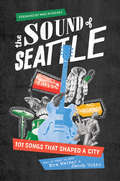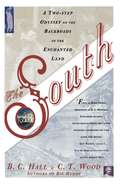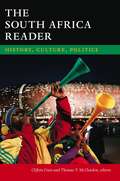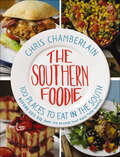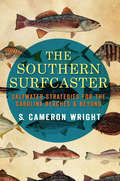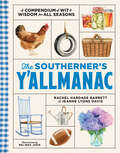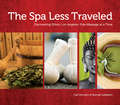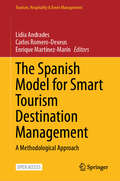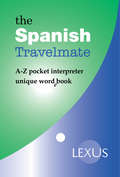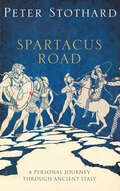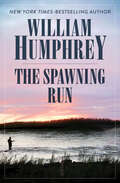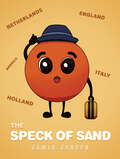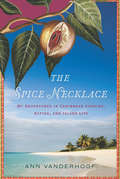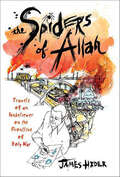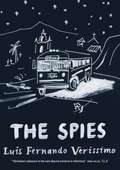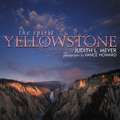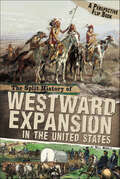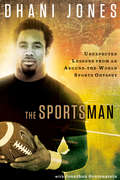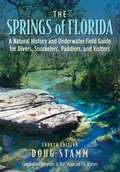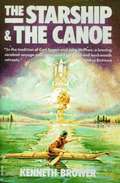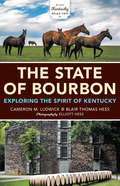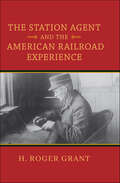- Table View
- List View
The Sound of Seattle: 101 Songs that Shaped a City
by EVA WALKER Jacob UittiThis rockin' paperback explores the musical evolution of Seattle through the lens of 101 songs spanning 80 years, examining the most prominent and important music and musicians to come out of our corner of the country, with a foreword by Pearl Jam legend Mike McCready.KEXP DJ and musician Eva Walker and music writer Jake Uitti take readers on a musical journey, exploring the songs and artists instrumental to developing the "Seattle sound." The authors have curated the ultimate playlist for the Emerald City. It all begins in 1942 when Washington-born Bing Crosby records what will become the world's bestselling single of all time, "White Christmas." From there, readers will delight in a sensory trip through jazz, rock, punk, riot grrrl, pop, rap, grunge, indie, emo, and more, deepening their knowledge and love of the songs that shaped Seattle, and in the process, each of us.Both a love letter and love song to the city, The Sound of Seattle is a visual guide organized by decade, with seminal songs profiled and paired with inventive design reminiscent of a favorite zine or concert poster. Includes interviews with Seattle legends like Heart's Nancy Wilson, as well as sidebars showcasing musical landmarks throughout the city. How has the Emerald City&’s musical output changed and evolved? What is the connective tissue between Ray Charles, Quincy Jones, and Kenny G? Between Melvins, Sleater-Kinney, and Foo Fighters? Between Sir Mix-a-Lot, Macklemore, and Travis Thompson? We're gonna find out!
The South
by B. C. HallA tour through the history, politics, and culture of the South is complemented by interviews with such figures as William Fulbright, Daisy Bates, Rosa Parks, Jimmy Buffett, and Shelby Foote.
The South Africa Reader: History, Culture, Politics
by Clifton Crais Thomas V. McclendonThe South Africa Reader is an extraordinarily rich guide to the history, culture, and politics of South Africa. With more than eighty absorbing selections, the Reader provides many perspectives on the country's diverse peoples, its first two decades as a democracy, and the forces that have shaped its history and continue to pose challenges to its future, particularly violence, inequality, and racial discrimination. Among the selections are folktales passed down through the centuries, statements by seventeenth-century Dutch colonists, the songs of mine workers, a widow's testimony before the Truth and Reconciliation Commission, and a photo essay featuring the acclaimed work of Santu Mofokeng. Cartoons, songs, and fiction are juxtaposed with iconic documents, such as "The Freedom Charter" adopted in 1955 by the African National Congress and its allies and Nelson Mandela's "Statement from the Dock" in 1964. Cacophonous voices--those of slaves and indentured workers, African chiefs and kings, presidents and revolutionaries--invite readers into ongoing debates about South Africa's past and present and what exactly it means to be South African.
The Southern Foodie's Guide to the Pig: A Culinary Tour of 50 of the South's Best Restaurants & the Recipes That Made Them Famous
by Chris ChamberlainA guide to purchasing, preparing, and cooking pork using the culinary traditions of the American South—includes photos, recipes and dining recommendations.Discover some of the essential tips and recipes behind the best pork dishes in the south with Chris Chamberlain, author of the popular The Southern Foodie Cookbook.Arguably the most democratic of all proteins, pork is welcome across the country from a gourmet pork belly dish on the menu of the toniest Charleston bistro to a whole hog roasting in a hole dug in the sand of a beach in LA (Lower Alabama).A geographic tour of the Southern states will showcase restaurants in the region that have special talents when it comes to pork. The chefs and pitmasters have shared some of their most sacred secrets, the actual recipes for the best pork, barbecue and bacon dishes that emerge from their kitchens.Since man cannot live by pig alone, there is also a selection of recipes that are great accompaniments to the pork dishes contributed by the fifty Southern restaurants that are featured.The Southern Foodie’s Guide to the Pig introduces readers to all the parts of this versatile animal and teaches procedures to prepare all sorts of wonderful dishes.
The Southern Foodie: 100 Places to Eat in the South Before You Die (and the Recipes That Made Them Famous)
by Chris ChamberlainThirteen states, 100 chefs and 134 recipes later, one thing is clear: the food of the American South tells a story that spans the distance from New Orleans to Louisville, Little Rock to Charleston, Nashville to Dallas, and every city in between.Meet the people keeping the tradition alive and reinventing the flavors of the South while exploring its evolution of the region&’s best restaurants.Swing down to the Gulf Coast and wade into a chef&’s wonderland of fresh seafood and spicy heat. Check out the culinary creativity in the Carolinas where you&’ll find traditional smoked pork barbecue alongside Southern favorites made with fresh, local produce. Explore the restaurant kitchens of Atlanta and Nashville where the chefs aren&’t shy about fusing comfort food standards with international flair and unexpected techniques. Join food and drink writer Chris Chamberlain for access to the South&’s best recipes and the kitchens where they were developed. In The Southern Foodie, Chamberlain explores the South&’s culinary culture with favorites such as: Jalapeño-and-Cheese-Stuffed Grit Cakes from Mason&’s Grill, Baton Rouge, LARoasted Heirloom Pumpkin with Mulled Sorghum Glaze from Capitol Grille, Nashville, TNCountry Ham Fritters from Proof on Main, Louisville, KYBlue Crab Cheesecake from Old Firehouse Restaurant, Hollywood, SCApricot Fried Pies from Penguin Ed&’s Bar-B-Q, Fayetteville, AR The Southern Foodie you where the South eats and how to create those distinct flavors at home. You&’re sure to rediscover old favorites and get a closer look at the delicious new traditions in Southern cuisine.
The Southern Surfcaster: Saltwater Strategies For The Carolina Beaches And Beyond
by S. Cameron WrightThe Southern Surfcaster will increase your knowledge of fishing and help you develop into a more confident salt-water fisherman. Explore creative techniques and the latest strategies that have transformed the sport over the last decade. Many of the old-school methods of fishing are updated for modern practicality. The Southern Surfcaster will change the way you think and what you thought you knew about salt water fishing.
The Southerner's Y'allmanac: A Compendium of Wit & Wisdom for All Seasons
by Rachel Hardage BarrettCelebrate southern living with this beautiful seasonal almanac chock-full of 100+ fun and practical ideas for decorating, entertaining, cooking, and gardening.With 150+ stunning photos and illustrations, and charming Southern witticisms, it&’s the perfect gift for anyone who loves the South.Southern charm abounds in this lighthearted compendium to what makes the region so very special. Created by lifelong southerners Rachel Hardage Barrett, editor in chief of Country Living, and Jeanne Lyons, their insider&’s guide includes:Entertaining ideas for any occasion from casual porch parties to an off-to-the-races Derby party and spirited gameday tailgates Southern interiors inspiration including welcoming kitchens, laid-back living spaces, and brake-worthy exteriorsWit and wisdom from prominent Southerners including how to wear seersucker to the art of selecting a monogramFresh twists on Southern recipes including Cheerwine Ribs, Pimento Cheese Deviled Eggs, and Hummingbird Bundt CakeNew ways to enjoy the garden from must-grow tomatoes to ways to display your favorite bloomsDelightful small-town escapes including the region&’s best U-pick farms, must-see soda fountains, and can&’t miss county fairOrganized by seasons, it's the quintessential southern gift book (and housewarming present!) for anyone who loves the South.
The Spa Less Traveled
by Gail Herndon Brenda GoldsteinLos Angeles' remarkable ethnic diversity has brought more than exotic food and rich cultural traditions--it's led to a wealth of incredible (and incredibly inexpensive) therapeutic massage treatments. Gail Herndon and Brenda Goldstein, both health-care professionals, spent five years visiting Southern California's Thai, Korean, Chinese, Russian, Japanese, Indian, and Hawaiian spas, and they share the details on their favorites. They explain the treatments and their benefits and tell you where to go, what to expect, how to tip, even where to park and where to eat in the neighborhood. A beautifully photographed and designed gift for adventurous Southern Californians.
The Spanish Model for Smart Tourism Destination Management: A Methodological Approach (Tourism, Hospitality & Event Management)
by Lidia Andrades Carlos Romero-Dexeus Enrique Martínez-MarínThis is an open access handbook that guides destinations on their journey to becoming Smart Tourism Destinations (STDs). Developed by SEGITTUR, a distinguished Spanish State company, and aligned with academia represented by Professor Lidia Andrades, who has brought together recognized international academics with SEGITTUR experts in the field of tourism management to write this groundbreaking book, it offers practical insights and strategies for success. Explore the characteristics and implications of smart destinations, across the five dimensions which structure them: destination governance, accessibility, technology, innovation and sustainability, navigate the transition from traditional tourism management to the innovative smart managerial paradigm, and overcome challenges encountered during the transformative process. Equipping destination managers with essential tools and strategies, this handbook showcases real-life examples of Spanish destinations embracing the smart tourism paradigm. Drawing on SEGITTUR's proven methodology, it provides precise guidance, checklists, and expert recommendations for effective implementation. An invaluable resource for destination managers, tourism professionals, and researchers, it unlocks the full potential of smart tourism destinations.
The Spanish Travelmate
by Lexus Alicia de Benito Harland Mike HarlandThe Spanish Travelmate phrasebook and dictionary gives you a detailed yet easy-to-use A to Z list of English words and phrases with Spanish translations for quick-find reference. There are more than 3500 words and phrases, and the Spanish translations come together with an easy-to-read pronunciation guide. Tap a hyperlink (there are hundreds of them) to go to special sections: travel tips about being in Spain; basic language notes; typical Spanish replies to your Spanish questions; conversion tables. These are features which make the Travelmate the must-have ebook Spanish phrasebook download for the traveller who wants to really communicate. The Spanish Travelmate phrasebook and dictionary also gives you a detailed Spanish menu reader of over 500 items and a dictionary section with translations of over 300 common Spanish signs and notices. This is the little book that's a big help. And a joined-up language experience.
The Spartacus Road: A Personal Journey Through Ancient Italy
by Peter StothardA classicist retraces the ancient journey taken by the Spartacus and his army of rebels through Italy in the first century BC Gladiator War.In the final century of the first Roman Republic, an army of slaves undertook a historic revolt. Led by the gladiator Spartacus, its success was something no one before had ever known. The Spartacus Road is the route along which this rebel army outfought the Roman legions between 73 and 71BC, bringing both fears and hopes that have never wholly left the modern mind. It is a road that stretches through 2,000 miles of Italian countryside and out into 2,000 years of world history.In this inspiring and original memoir, the former editor of The Times, Peter Stothard, takes us on an extraordinary journey. The result is a book like none other: at once a journalist’s notebook, a classicist’s celebration, a survivor’s record of a near fatal cancer and the history of a unique and brutal war. As he travels along the Spartacus road—through the ruins of Capua to Vesuvius and the lost Greek cities of the Italian south—Stothard illuminates conflicting memories of times ancient and modern, breathing new life into one of the greatest stories of the ages.
The Spawning Run
by William HumphreyWilliam Humphrey's delightful chronicle of an angling holiday in Wales celebrates two equally astonishing creatures: the Atlantic salmon and the British fly fisherman In order to mate in the same freshwater stream where it was spawned, the salmon swims one thousand miles or more and overcomes countless obstacles, from trawling nets to twelve-foot-high waterfalls. To catch the King of Fish at the end of its incredible journey, the Anglo-Saxon angler subjects his pride, his bank account, and his taste buds--poached milk, anyone?--to similar dangers. Nine out of ten salmon do not make it back to the sea once their spawning run is finished; nine out of ten sportsmen return to the hotel empty handed when the fishing day is done. And yet, year after year, they return to the rivers and streams of Great Britain--fish and angler both. Why? Perhaps "poor Holloway," who has yet to land a salmon after twenty spawning seasons but whose success rate with the bored wives of more skillful fisherman is scandalously impressive, knows the answer. An elegant blend of fishing narrative, travelogue, and character study, The Spawning Run is a hilarious and heartfelt tribute to the irresistible passions that unite us all: man, woman, and salmon. This ebook features an illustrated biography of William Humphrey including rare photos form the author's estate.
The Speck of Sand
by Jamie JensenJoin The Speck of Sand on an unexpected journey, as it tumbles, flies, and clings to travelers from all over the world.Along the way, The Speck of Sand visits different countries and villages, learning about their unique histories.Use the included maps to follow the travelers and The Speck of Sand as they explore together.
The Spice Necklace: My Adventures in Caribbean Cooking, Eating, and Island Life
by Ann VanderhoofThe author of An Embarrassment of Mangoes offers &“a mouthwatering slice of Caribbean culture&” in this blend of travel memoir and cookbook (New York Post). While sailing around the Caribbean, Ann Vanderhoof and her husband Steve track wild oregano-eating goats in the cactus-covered hills of the Dominican Republic, gather nutmegs on an old estate in Grenada, make searing-hot pepper sauce in a Trinidadian kitchen, cram for a chocolate-tasting test at the University of the West Indies, and sip moonshine straight out of hidden back-country stills. Along the way, they are befriended by a collection of unforgettable island characters: Dwight, the skin-diving fisherman who always brings them something from his catch and critiques their efforts to cook it; Greta, who harvests sea moss on St. Lucia and turns it into potent Island-Viagra; sweet-hand Pat, who dispenses hugs and impromptu dance lessons along with cooking tips in her Port of Spain kitchen. Back in her galley, Ann practices making curry like a Trini, dog sauce like a Martiniquais, and coo-coo like a Carriacouan. And for those who want to take these adventures into their own kitchens, she pulls 71 delicious recipes from the stories she tells, which she places at the end of the relevant chapters. The Spice Necklace is a wonderful escape into a life filled with sunshine (and hurricanes), delicious food, irreplaceable company, and island traditions.
The Spiders of Allah: Travels of an Unbeliever on the Frontline of Holy War
by James HiderIn his fascinating, terrifying and often very funny book, James Hider takes his doubts about religious beliefs straight into the dark heart of the world's holy wars—from Israel to Gaza to Iraq—the birthplace that spawned so many faiths—and then back to Jerusalem. From hardcore Zionist settlers still fighting ancient Biblical battles in the hills of the West Bank to Shiite death squads roaming the lawless streets of Iraq in the aftermath of Saddam; whether it's the misappropriation and martyrdom of Mickey Mouse by Gaza's Islamists, or a US president acting on God's orders, Hider sees the hallucinatory effect of what he calls the 'crack cocaine of fanatical fundamentalism' all around him. As he meets terrorists, suicide bombers, soldiers, ayatollahs, clerics, and ordinary and extraordinary people alike, the question that sparked his journey continues to plague his thoughts: how can people not only believe in this madness, but die and kill for it too? This extraordinary and timely book takes the God Delusion debate onto the streets of the Middle East. It casts an unflinching yet compassionate eye on the very worst and most violent crimes committed in the name of religion, and then sharply asks the questions the world needs to answer if we are ever to stand a chance of facing our own worst demons.
The Spies
by Luís Fernando VeríssimoA frustrated publisher receives a mysterious angst-ridden manuscript: 'a friend' must send it in installments; its contents would put the author in danger. As he pieces together the story, he learns that the author is the wife of one of the two Martelli brothers - gangsters who dominate a small town in the Brazilian interior. Surely her dark outpourings are a cry for help? One by one, he dispatches his motley collection of friends to Frondosa - a town totally obsessed with five-a-side football - to investigate and to bring her to safety.
The Spirit of Hospitality: How to Add the Missing Ingredients Your Business Needs
by Larry StuartThe Spirit of Hospitality takes readers on a journey of passion for purpose that empowers the missing ingredients of hospitality into a proven leadership style that works. Time has sped up to the point where technology has surpassed the last few thousand years by only a generation. What happened to kindness, humility and the human touch vs. having our face buried into a laptop or IPhone? A life dedicated to excellence does not come by chance, or with age, but by choice and commitment. Larry Stuart strives to give The Spirit of Hospitality to others who are called to a life of prosperity and significance. He provides the tools, attributes and real-life examples of what works when it comes to serving up a memorable guest service delivery and describes the necessary ingredients of hospitality. There is hope only if individuals bring back the missing ingredients of kindness, humility, integrity, encouragement, generosity, team and accountability. Only then is the spirit of hospitality empowered to provide the right leadership approach in building relationships to a new level of expectation, and allows those who embrace that spirit to accomplish whatever they strive to achieve.
The Spirit of Yellowstone
by Judith L. MeyerYellowstone National Park's famous geysers, exotic landscape, and beautiful wildlife partially explain its enormous popularity, but there is something more to the Yellowstone experience—a powerful spirit to the place that is more than the sum of its parts. This fascinating history of America's favorite national park shows how that spirit has endured over Yellowstone's 127-year existence. Meyer shows that Yellowstone has consistently evoked awe in different generations of Americans, even as our attitudes toward nature have changed over the years. That awe is also captured in photographer Vance Howard's evocative images, which, alongside historic photographs and other early artistic interpretations of the Park's wonders, support Meyer's view that Yellowstone's unique sense of place makes it worth preserving not only for its ecological value but for its lasting importance in American culture.
The Split History of Westward Expansion in the United States (Perspectives Flip Books)
by Nell MusolfAmerican Indians had lived in North America for thousands of years by the time European settlers arrived. The settlers came in search of land and were eager to build farms, roads, and towns. The Indians lived off the land and believed it belonged to everyone. When the U.S. government completed the Louisiana Purchase in 1803, the plan to expand the country to the Pacific Ocean set up a collision course between the two groups' ways of life.
The Sportsman: Unexpected Lessons from an Around-the-World Sports Odyssey
by Jonathan Grotenstein Dhani JonesWith 11 seasons in the NFL, Dhani Jones had an unusually long career for a football player. But early on, Dhani thought his playing days were over. Cut by the Eagles and the Saints, he was at a professional crossroads. When the Bengals called, though, he was more than ready and in the best shape of his life. And for that, he credits his off-season.The Sportsman follows Dhani's discovery that the parts of his life, which to many seemed to be distractions—including an off-season TV show that sent him around the world to learn and compete in other sports—actually served to cross-train him in ways he'd never imagined, enabling him to become more grounded, globally aware, and, most surprisingly, a much better football player.Part travelogue, part workout guide, part inspirational memoir, The Sportsman is an invigorating account of Dhani's global sporting adventures and the lessons he learned along the way. From dragon boat racing in Singapore to carrying 300-pound rocks in Iceland and biking in Italy, Dhani's adventures taught him to be tougher, smarter, and stronger than ever. The Sportsman is a reminder that by connecting to the world through its people and customs and the spirit of competition, we empower ourselves in ways that can surpass our craziest expectations.
The Springs of Florida: A Natural History and Underwater Field Guide for Divers, Snorkelers, Paddlers, and Visitors
by Doug StammA rare collection of photographs that are the heart of The Springs of Florida was obtained over a period of many years. They are the result of hundreds of hours underwater, during both day and night, and in all seasons of the year. The many realms of fresh water that most often surround us are dark rivers, clouded ponds and the opaque depths of inland lakes. We cannot see into them or fathom the incessant activities of life that occurs throughout their depths. The many springs that jewel the landscape of Florida are ornate exceptions to an environment often veiled in obscurity. They are translucent openings to a dominion very rare: a crystalline and vibrant world of flowing fresh water that rises from the earth and reaches to the sea.Now in its fourth edition, The Springs of Florida brings updated research and discussion to readers interested not only in the ecosystem and environment, but also in preserving the springs and the creatures that reside there. Doug Stamm, prominent voice in the Florida springs community and professional diver/underwater photographer, aims to increase awareness about springs conservation as well as bring new updates to light in his text. With a combination of legacy and new photos throughout the book, readers will see first-hand how beautiful the springs are and learn why conservation efforts are needed now more than ever.
The Starship and the Canoe
by Kenneth BrowerThe story of a father and son who search for life's meaning in very different ways. "In the tradition of Carl Sagan and John McPhee, a bracing cerebral voyage past intergalactic hoopla and backwoods retreats. "--Kirkus Reviews
The State of Bourbon: Exploring the Spirit of Kentucky
by Blair Thomas Hess Cameron M. Ludwick Elliott HessWelcome to Kentucky, where bourbon barrels outnumber residents. After all, bourbon is Kentucky—its craftsmanship and flavors cannot be separated from the culture and history of the state. Discover that culture and history—and enjoy great food, fabulous drinks, and incredible people—on your own Kentucky bourbon road trip. The State of Bourbon showcases the region's finest distilleries as well as the local restaurants, hotels, parks, and adventures that every bourbon lover needs to experience. Bluegrass natives Cameron M. Ludwick and Blair Thomas Hess highlight some of their favorite stops on the Kentucky Bourbon Trail, the Urban Bourbon Trail, and the Craft Bourbon Trail, at stills and rick houses where the history and heritage of the nation's only native spirit come to life. Not just a trail or tasting guide, The State of Bourbon will lead you across Kentucky, through the history of the spirit, and into your own bourbon adventure.
The Station Agent and the American Railroad Experience (Railroads Past and Present)
by H. Roger GrantBefore the widespread popularity of automobiles, buses, and trucks, freight and passenger trains bound the nation together. The Station Agent and the American Railroad Experience explores the role of local frontline workers that kept the country's vast rail network running.Virtually every community with a railroad connection had a depot and an agent. These men and occasionally women became the official representatives of their companies and were highly respected. They met the public when they sold tickets, planned travel itineraries, and reported freight and express shipments. Additionally, their first-hand knowledge of Morse code made them the most informed in town. But as times changed, so did the role of, and the need for, the station agent.Beautifully illustrated with dozens of vintage photographs, The Station Agent and the American Railroad Experience, brings back to life the day-to-day experience of the station agent and captures the evolution of railroad operations as technology advanced.
